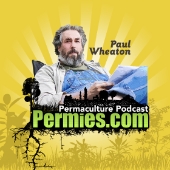I gather at least some trees need competition in order to become the specimen that we might read about in Wikipedia. While things are not as dry here as Joe Lofthouse (sp?) sees, we are borderline desert and at least my property is (in the words of Alan Savory (sp?)) brittle. It dies, it falls on the ground, it doesn't rot. No sand to speak of and few rocks, lots of clay though (former glacial lake bottom).
We have lots of wind (downwind of wind farm), and so shelter from the wind is an issue. The property runs approximately perpendicular to the wind and is 660 feet wide. So, if I had 100 foot tall trees on the west side, they would probably shelter the rest of the land from the wind. What we have for trees are aspen, willow and some poplar. Birch and tamarack might be in some locations nearby. In relatively open land, if an extensive colony of aspen can get going, you could see 40 foot tall aspen (or so). Sometimes relief gives more shelter, and you could get 60 feet. I've seen some places where trees leeward of a hilltop, will not grow beyond the shelter of the hilltop. An isolated aspen is doomed. And so many people are cutting down the aspen.
What can survive the wind, live in low water conditions and be useful? A wild guess I chose Bur (or Burr) Oak. I've looked a bit, but it is hard to find data on how big this tree is. You see the odd summary here and there, and you can read about the odd extremes here and there. But nothing to wrap an equation around.
It is some kind of growth curve. It will have a lower shelf of 0 (hard to be a negative height tall) and it probably has an upper shelf. It should have 2 main transition regions, from seedling to juvenile, and from mature to end-phase. There may be a transition at juvenile to mature (mature being it produces fruit I guess).
In any event, I happened across the 5 parameter logistic curve, with inadequate explanation of what was what, which led to the 4 parameter Janoschek curve. Some data related to grow rate, and some data related to height at a specific age. And some data is conflicting (same age, different heights). And no estimates as to variability.
Two of the Janoschek parameters are the dependent variable (height) at 0 time and in old age. At 0 time, it is 0. We are down to 3 parameters now. The curved part of the data comes from a single exponential term containing -k t^delta (2 parameters, k and delta).
Feeding parameters drawn from random number generators at the data, I have a guess at the 3 parameters, sort of drawn from 31,000 or so fabricated data points.
k = 0.0125
delta = 1.2
height 70 feet
But, those parameters sort of come close to describing the tree height at 20, 35, 60, 70 and 80 years and the growth rate when young (in the vicinity of 12 inches per year). There were guesses at parameter values that couldn't come close to the data, so that is the only filtering that was done on this. There was lots of variation thrown at the model. I think the tallest tree tried was something like 150 feet tall (at end of life, at least in 1 version of the code).
The average height of a tree at end of life is probably a function of a bunch of things. It wouldn't surprise me if k and delta also are related to those things.
On the farm, someone did some work a coupe of years after I finished high school and was gone (mid to late 1980s). So, there are trees which were transplanted to the farm, some as seedlings, some as small trees and some probably as bigger trees. One weeping birch has largely been killed by yellow bellied sapsuckers. But, seedling and small tree variations of pine and spruce are here, all in the 30 or so year age range. The tallest might be 25 feet, average is probably 15, some less than 6. Some planted in vicinity of others where competition might take place. A couple planted out in the open with no competition.
But, if a person is going to plant competition for windbreak trees to get them to grow, I think you pretty much need to run things inside a program like blender to find out where the shadows of the competing trees are with respect to the tree you are trying to incite to grow. Lots of you have rules that work for where you live (in essence, your blender model is embedded in your head), but you are living south of the 49th parallel and I am pretty close to 56N. How high the sun gets in the sky is much different, and our day length in the summer is much longer than yours.
Maybe someone did this work? Where is it?

I have a bunch of different target trees in mind, and I was hoping to use black locust (and maybe I think it is grey alder or green alder) to incite them to grow.
If you know of software along the line, that would be nice. Microsoft and Apple not spoken here. The work I did above, is in Perl.
Good luck with your forest.

 1
1









 2
2











